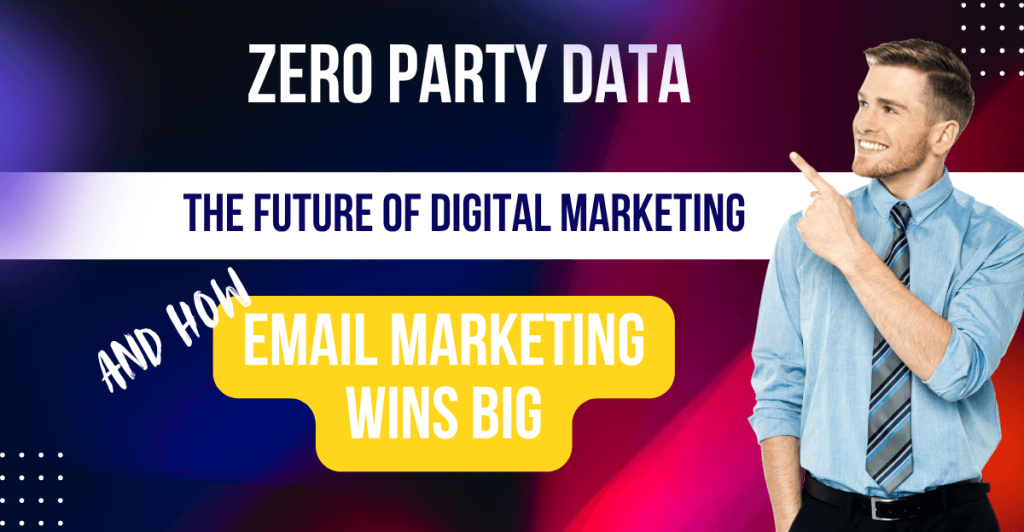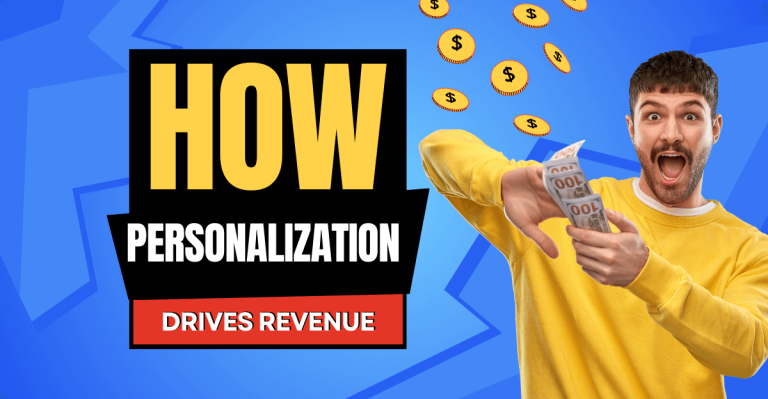What Is Zero Party Data?
Zero Party Data Definition
Zero party data is the most deliberate and transparent type of consumer data available to marketers today. Unlike data collected through cookies, behavioral tracking, or third-party sources, zero party data is willingly and proactively shared by the customer—with intention and clarity. It encompasses a broad spectrum of insights, including product preferences, style choices, personal values, future purchase plans, preferred communication channels, and even emotional triggers that influence buying decisions.
This data isn’t extracted—it’s offered freely by customers who expect something meaningful in return, such as personalized recommendations, early access to products, or tailored offers. Because it’s grounded in consent and transparency, zero party data is inherently more accurate, relevant, and privacy-compliant. It reflects not just what a customer does, but what they actually want and care about, making it the foundation for truly human-centric marketing.
For brands, this opens up a world of opportunity—not only to deliver deeply personalized, high-performing campaigns, but also to establish long-term trust and loyalty in a digital landscape where privacy and authenticity are everything. As regulations like GDPR, CCPA, and others continue to tighten around passive data collection, embracing zero party data isn’t just a competitive advantage—it’s a future-proof strategy for sustainable, ethical, and scalable growth in the age of privacy-first marketing.
Zero Party Data Meaning vs. Other Data Types
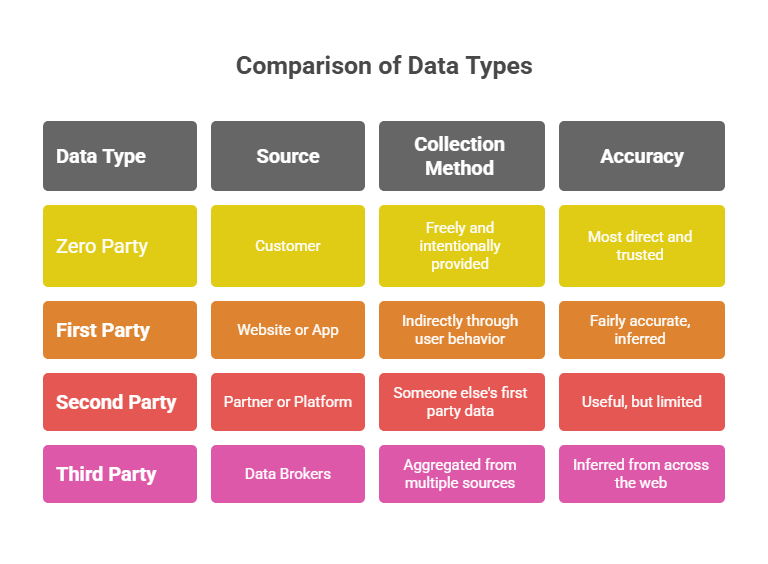
To fully grasp the value of zero party data, it’s helpful to contrast it with the other types of consumer data commonly used in digital marketing:
- Zero Party Data: This is the most direct and trusted form of data—freely and intentionally provided by the customer. Examples include answers to quizzes, product preferences, dietary needs (e.g., “I prefer vegan recipes”), or desired shopping frequency. It’s data you don’t have to guess at—because the customer tells you outright.
- First Party Data: Collected indirectly through user behavior on your website or app, such as clicks, purchase history, time spent on a page, or abandoned cart items. While still owned by the brand and fairly accurate, it’s inferred, not explicitly declared.
- Second Party Data: This is someone else’s first party data that’s shared with your brand through partnerships or platforms. For example, a travel brand might share traveler data with a luggage retailer—useful, but limited in scope and control.
- Third Party Data: Often aggregated from multiple sources and purchased through data brokers, this includes demographics, interests, and behaviors inferred from across the web. It’s becoming increasingly unreliable and controversial due to growing privacy regulations.
In today’s privacy-first digital landscape, zero party data stands out as the gold standard. It’s not only more accurate and compliant but also signals a deeper level of engagement and trust between your brand and your customer. Rather than chasing insights through analytics, zero party data empowers you to ask, listen, and deliver—directly.
Why Zero Party Data Is Crucial in 2025
Consumer Trust and Data Privacy
In an era where digital surveillance is under the microscope and third-party cookies are rapidly vanishing, consumer expectations around data privacy have evolved dramatically. Today’s customers are more informed and more protective of their personal information than ever before. They’re no longer passive participants—they’re demanding transparency, control, and accountability from the brands they engage with.
This shift in sentiment presents both a challenge and an opportunity. Brands that continue to rely on opaque data practices risk alienating their audiences and falling out of step with emerging regulations like GDPR, CCPA, and ePrivacy. On the flip side, those who prioritize ethical data collection—particularly through mechanisms like zero party data—are building a competitive edge grounded in trust.
By allowing users to voluntarily share their preferences, needs, and intentions—and clearly communicating how that data will be used—brands not only foster transparency but also demonstrate respect for their customers’ digital boundaries. This builds brand integrity, long-term loyalty, and higher engagement. In short, empowering customers with choice isn’t just good ethics—it’s smart marketing in a privacy-first world.
Regulation and Compliance
With the enforcement of global privacy regulations like GDPR (General Data Protection Regulation) in Europe, CCPA (California Consumer Privacy Act) in the U.S., and a wave of similar frameworks worldwide, the landscape of data collection has fundamentally changed. These laws demand that businesses collect data transparently, obtain clear consent, limit unnecessary tracking, and provide users with control over how their data is used and stored.
In this new regulatory environment, many traditional data strategies—like third-party cookies and behavioral tracking—are becoming legally risky and operationally complex. That’s where zero party data shines. Because it is intentionally shared by the customer with full awareness, it is inherently compliant with privacy laws. There’s no ambiguity: the user chooses what to share, and the brand only stores what’s relevant and consented to.
For e-commerce businesses, this means less legal uncertainty and greater operational clarity. By focusing on zero party data, brands can future-proof their marketing, build audit-ready data practices, and stay ahead of evolving compliance demands—while simultaneously delivering the personalized experiences that customers crave.
Zero Party Data vs. First Party Data
Difference Between Zero and First Party Data
| Feature | Zero Party Data | First Party Data |
|---|---|---|
| Source | Voluntarily provided by users | Observed by brand through behavior |
| Accuracy | High (user-stated) | Medium (inferred from actions) |
| Privacy Compliance | Strong (explicit consent) | Good, but less transparent |
| Usage | Personalization, segmentation, prediction | Analytics, retargeting, content customization |
Zero party data enables deeper personalization because it’s based on what people actually say they want—not just what they do.
How Email Marketing Enables Zero Party Data
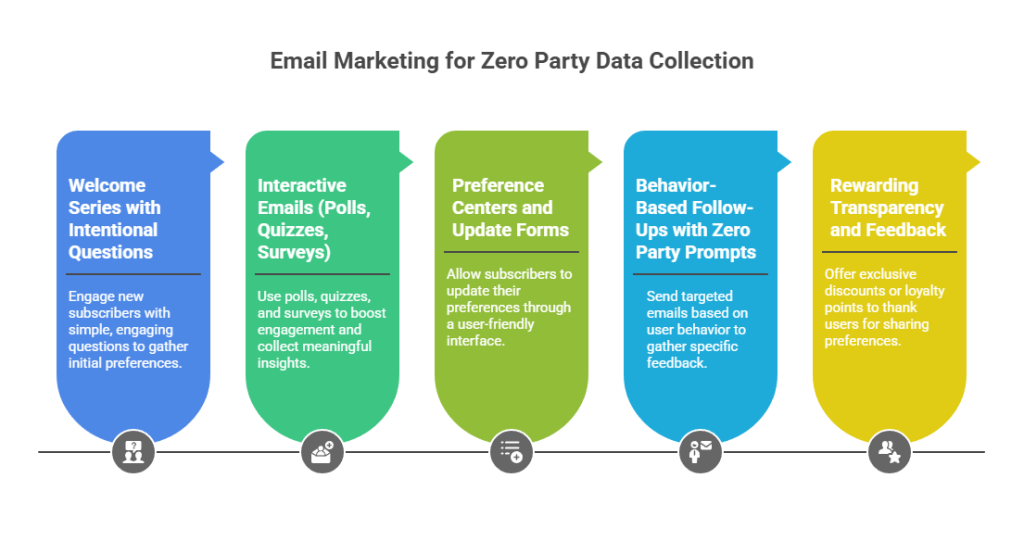
Email marketing is uniquely positioned as the most direct, permission-based, and personalized channel for collecting zero party data—and it’s one that consumers already trust. Unlike social media or paid ads, email is a one-on-one conversation initiated with explicit consent (through opt-ins), making it the ideal environment to ask customers directly about their preferences, intentions, and needs.
Here’s how email marketing powers zero party data collection:
- Welcome Series with Intentional Questions
Use your onboarding emails to learn about your subscribers. Ask simple, engaging questions like “What are you shopping for today?” or “What styles do you love?” These early interactions allow you to start segmenting users based on their self-declared interests. - Interactive Emails (Polls, Quizzes, Surveys)
Add embedded polls, clickable quizzes, or short surveys within newsletters or promotions. For example, “Help us help you—what colors do you prefer?” or “Pick your go-to skincare concerns.” This interactive format boosts engagement while collecting meaningful insights. - Preference Centers and Update Forms
Give subscribers the ability to update their preferences at any time through a user-friendly preference center. Let them select how often they want to hear from you, what types of content they prefer (e.g., new arrivals, clearance, styling tips), and which product categories interest them most. - Behavior-Based Follow-Ups with Zero Party Prompts
If someone clicks a specific product link or abandons a cart, follow up with a targeted email that includes a quick question like, “Was this item the right style for you?” or “Would you like us to suggest similar products?” - Rewarding Transparency and Feedback
Thank users for sharing their preferences with exclusive discounts, early access to collections, or loyalty points. Make it clear that their input is helping shape a better shopping experience—this builds trust and encourages more voluntary data sharing.
By positioning email as a two-way conversation, rather than just a sales tool, e-commerce brands can turn routine messages into powerful, privacy-friendly data collection engines—without compromising trust or compliance.
Zero Party Data Examples in Email Campaigns
Zero party data thrives in email campaigns because they provide a direct line to the consumer—making it easy to ask, receive, and respond with value. Below are concrete examples from different industries, along with actionable ways brands can implement them to enhance personalization and improve customer experience.
Retail & E-commerce
- Fashion Retailer
Upon signing up for the email list, a fashion brand sends a welcome email titled:
“Let’s Discover Your Style”
Inside is a short quiz or image carousel asking the subscriber to choose their favorite looks, sizes, and color preferences.- Email Marketing Pro Tip: Store this data to dynamically populate future product recommendations and seasonal collections. Pair this with size-based filtering to avoid promoting out-of-stock or irrelevant items.
- Food & Beverage Brand
A gourmet food company asks new subscribers:
“Are you vegan, gluten-free, or all about indulgence?”
Alongside cuisine choices (e.g., Italian, Asian, Mediterranean), this lets the brand tailor recipe content and product bundles.- Email Marketing Pro Tip: Use dietary tags to segment users for recipe emails, seasonal boxes, or exclusive content like “5 Quick Vegan Dinner Ideas.”
SaaS & Service Industries
- Project Management Tool
During the onboarding email series, users are prompted to select their top goals:
“What are you here for?”
Options include: “Team Collaboration,” “Task Management,” “Client Reporting,” and more.- Email Marketing Pro Tip: Trigger tutorial emails and feature highlights based on selected goals, reducing overwhelm and increasing time-to-value.
- Online Education Platform
After sign-up, the first email invites learners to choose their:- Experience level: Beginner, Intermediate, Expert
- Learning objectives: Career switch, skill sharpening, or hobby
- Preferred format: Video, Text, or Hybrid
- Email Marketing Pro Tip: Segment learners into personalized learning paths. For example, “Beginner Web Developers” receive a curated syllabus and weekly challenges aligned with their goal.
Each of these examples illustrates how zero party data can transform a generic email list into a precision-targeted marketing engine. By asking the right questions at the right time, brands can deliver highly relevant content, reduce friction in the buyer journey, and create memorable user experiences that drive long-term loyalty.
Zero Party Data Collection Strategies
How to collect zero party data
Collecting zero party data doesn’t have to be complicated—it just needs to be intentional, interactive, and value-driven. Below are two highly effective strategies that not only boost engagement but also make customers feel heard and appreciated while sharing useful insights.
1. Contests and Giveaways
Running a giveaway is one of the most organic ways to collect zero party data—because users are already motivated by the potential reward. It provides the perfect moment to ask them relevant, non-intrusive questions that reveal their product preferences, style choices, pain points, or purchase intentions.
Example Use Case for E-commerce:
A beauty brand runs a “Win Your Dream Skincare Routine” contest. To enter, users must answer 3 short questions:
- What’s your skin type? (Oily, Dry, Combination, Sensitive)
- What are your biggest skin concerns? (Acne, Aging, Redness, Dullness)
- What price range do you usually shop in?
Actionable Tips:
- Segment users based on answers to build post-contest nurture emails.
- Offer a consolation prize (like 10% off personalized bundles) to all entrants using their selected preferences.
- Clearly communicate how the answers will help improve product recommendations.
2. Polls, Quizzes, and Feedback Forms
Interactive content like polls and quizzes turns passive readers into engaged participants—while giving you clean, user-provided data that’s perfect for segmentation.
Example Use Case for E-commerce:
An activewear brand includes a short quiz in its newsletter:
“What’s Your Workout Style?”
With options like Yoga Enthusiast, Gym Rat, Outdoor Runner, or CrossFit Warrior.
Based on responses, customers are added to dynamic segments:
- Yoga fans get offers on leggings and mats.
- Runners see hydration packs and running shoes.
Email Marketing Pro Tips:
- Use feedback forms post-purchase to ask, “Did you find what you were looking for?” or “How was your product experience?”
- Gamify the quiz by offering users a “style personality” result at the end or a discount for completing it.
- Keep it short (under 5 questions) to reduce drop-off.
These strategies make data collection feel more like a conversation than a transaction, and the insights you gain can dramatically increase the relevance, performance, and ROI of your email marketing campaigns.
Benefits of Using Zero Party Data in Email
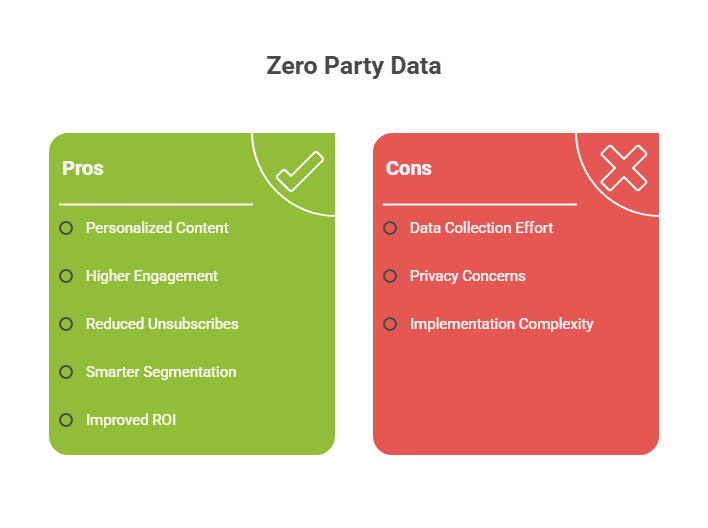
Zero party data is a game-changer for email marketing. Unlike traditional data, which is inferred or purchased, this data comes directly from the source—your customers. That makes your email campaigns not only smarter, but also more human and impactful. Here’s how:
1. Personalized Content That Truly Resonates
When you know exactly what a subscriber wants—because they told you—you can deliver emails that feel like they were written just for them.
Example:
If a user indicates they love minimalist fashion, your emails can spotlight clean designs, muted tones, and curated outfit ideas. No more guesswork.
✅ Result: Higher customer satisfaction, more add-to-cart actions, and repeat visits.
2. Higher Engagement Rates Across the Board
People are more likely to open, click, and interact with emails that reflect their stated preferences, lifestyle, or goals.
Example:
Email subject lines like “New gluten-free snacks you’ll love” based on dietary preferences lead to increased open and click-through rates, often 2x higher than generic blasts.
✅ Email Marketing Pro Tip: Use A/B testing to refine personalized subject lines and layouts.
3. Reduced Unsubscribe Rates and List Churn
By honoring subscriber preferences, you avoid over-sending, irrelevant promos, or frequency fatigue—all of which cause unsubscribes.
Example:
If a customer opts in for monthly updates instead of weekly, stick to it. Use automation to enforce those preferences at scale.
✅ Bonus: Fewer unsubscribes = healthier sender reputation and better inbox placement.
4. Effortless Segmentation and Smarter Automation
Zero party data makes segmentation cleaner and more intuitive. No need to analyze behavior when the user already told you what matters.
Example:
Segment your list by product category interest (e.g., “Men’s Activewear,” “Pet Supplies,” “Luxury Skincare”) and send automated sequences tailored to each one.
✅ Quick Win: Combine zero party data with dynamic content blocks for one email that adapts to 10 segments.
5. Improved ROI from Every Campaign
When your messaging aligns with real user intent, it converts better. That’s the core value of zero party data—it connects you directly to what drives purchase decisions.
Example:
A subscriber who selects “Work-from-home essentials” during onboarding is far more likely to click and convert on emails offering ergonomic chairs or noise-cancelling headphones.
✅ Insight: Even small data points (like color or price preference) can influence conversion rates significantly.
In short, zero party data transforms email from a broadcast channel into a conversation, allowing brands to show up in subscribers’ inboxes with relevance, respect, and real value—every time.
Zero Party Data Strategy for Marketers
Collecting zero party data is just the beginning. To unlock its full value, marketers need a well-structured strategy that turns insights into personalized experiences. A smart zero party data strategy connects every stage of the customer lifecycle—from first interaction to post-purchase re-engagement—with targeted messaging that reflects what the user has willingly shared.
Here are two of the most effective ways to put your zero party data into action:
1. Lifecycle Email Sequences Built on Real Preferences
Your email marketing should evolve as your relationship with the customer deepens. By using zero party data at key lifecycle stages, you can automate email flows that feel personal and relevant at every touchpoint.
Implementation Examples:
- New Subscribers: Based on style preferences or product interests selected at sign-up, send a curated welcome series that introduces relevant categories (e.g., “Shop your sustainable picks”).
- First-Time Buyers: Use purchase intent or lifestyle data to trigger post-purchase guides (e.g., “How to style your new activewear”).
- Repeat Customers: Send loyalty rewards, early-access offers, or personalized product roundups based on previously declared interests or goals.
✅ Email Marketing Pro TIp: Map out your email flows based on zero party tags (e.g., +Skincare, +PetLover, +BudgetShopper), and match content at each lifecycle stage.
2. Segmentation & Dynamic Content for Hyper-Personalization
One of the most powerful uses of zero party data is to create highly segmented campaigns or even fully personalized emails using dynamic content blocks—sections of an email that change depending on user data.
Implementation Examples:
- Product Preferences: If a user selected “Vegan Beauty Products,” dynamically insert cruelty-free makeup collections or clean skincare picks into their newsletters.
- Style Tags: Show product imagery and text tailored to chosen styles—like “Boho,” “Minimalist,” or “Classic.”
- Budget Ranges: Send pricing-appropriate recommendations (e.g., “Under $50 Deals” vs. “Premium Picks”).
✅ Tool Suggestion: Use your email platform’s dynamic content feature (available in platforms like Klaviyo, ActiveCampaign, Mailchimp) to streamline this process.
Bonus: Build a Zero Party Data Feedback Loop
- Step 1: Ask the right questions at signup or post-purchase.
- Step 2: Store and tag this data in your CRM or ESP.
- Step 3: Deliver tailored content and measure engagement.
- Step 4: Refine your segments and content based on evolving preferences.
By making zero party data the engine of your email strategy, you’ll transform one-size-fits-all messages into customer-first experiences that boost engagement, conversion, and retention—without sacrificing trust or privacy.
Challenges and Best Practices
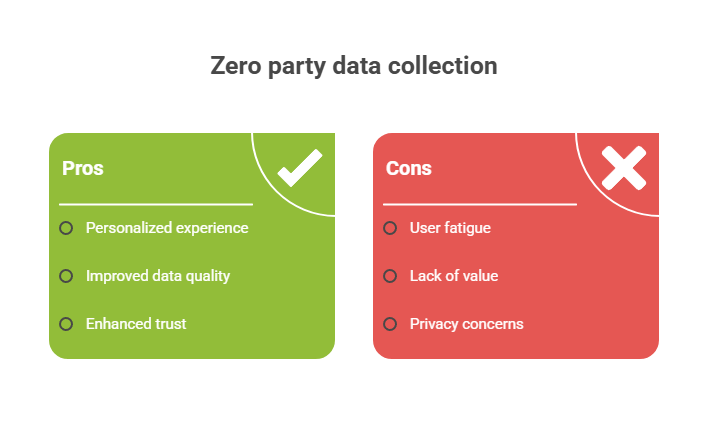
While zero party data is incredibly powerful, it must be handled with care, clarity, and customer empathy. Asking users to share personal insights is a privilege—one that requires trust and thoughtful execution. Here’s how to navigate the challenges and apply best practices that enhance both user experience and data quality.
1. Avoiding Fatigue: Make Sharing Effortless and Gradual
Challenge:
Asking too many questions upfront—or too often—can overwhelm users and lead to drop-offs, unsubscribes, or worse, a negative brand impression.
Best Practice:
Adopt a progressive profiling approach. Spread your questions across multiple touchpoints in the user journey rather than in a single form or email.
Example for E-commerce:
- Email 1: Ask “What products interest you most?”
- Email 2: “How often would you like to receive updates?”
- Email 3: “Do you prefer budget-friendly or premium collections?”
✅ Email Marketing Pro Tip: Use micro-interactions (like single-click answers or emoji reactions) to keep the experience light and friction-free.
2. Providing Value in Exchange: Make It Worth Their Time
Challenge:
Customers are more likely to engage when there’s clear value in it for them. Without this, even well-designed data requests may fall flat.
Best Practice:
Always frame your questions with a compelling benefit statement. Let users know how their answers will improve their experience—whether it’s better recommendations, personalized deals, or exclusive content.
Examples:
- “Tell us your favorite color so we can curate a collection just for you.”
- “Pick your skin type, and we’ll send you skincare tips that actually work.”
✅ Email Marketing Pro Tip: Sweeten the deal with a discount, freebie, or VIP access in exchange for preferences.
3. Be Transparent: Build Trust Through Clear Communication
Challenge:
In the era of data privacy concerns, users want to know exactly how their data is being used—and what it won’t be used for.
Best Practice:
Clearly state your intent when collecting data. Use plain language in your preference forms, privacy policies, and emails to explain how data enhances their experience and remains secure.
Examples:
- “We’ll use this info to send you personalized content—we’ll never share it.”
- “Your answers help us show only what’s relevant to you, not ads you don’t care about.”
✅ Email Marketing Pro Tip: Include a brief privacy note under each preference center or quiz explaining how their information will be used—and offer an easy way to update or remove it anytime.
By addressing these challenges with strategic care and human-centered design, brands can ensure that their zero party data practices feel more like a conversation—and less like a data grab. This not only improves participation rates but also strengthens the trust and long-term loyalty that zero party data is built upon.
Zero Party Data Marketing: Future Trends
As consumer expectations continue to evolve and technology advances, the future of digital marketing will be shaped by how intelligently and ethically brands use zero party data. Two major forces—AI and hyper-personalization—are leading this transformation.
AI + Zero Party Data: Smarter, Predictive, and Real-Time
Artificial Intelligence (AI) is set to supercharge the potential of zero party data. When customers willingly share their preferences and goals, AI tools can process this information at scale to deliver highly accurate and predictive marketing outcomes.
What This Looks Like in Practice:
- AI analyzes a user’s declared preferences and purchase history to predict what they’ll want next, even before they search for it.
- Recommendation engines evolve from basic “people also bought” to deeply personalized suggestions, like “Based on your workout style and color choices, here’s your perfect gym bag.”
- Real-time content generation: AI pulls from user-submitted data to craft email subject lines, product recommendations, and CTAs dynamically—unique to each individual.
✅ Why It Matters: This blend of AI and zero party data makes your marketing feel less like automation and more like a personalized concierge service—improving conversion rates, retention, and satisfaction.
Hyper-Personalization: Individualized Experiences at Scale
Gone are the days of segmenting users into just a few buckets. With zero party data, brands can unlock true hyper-personalization—where every email, website visit, and product recommendation is unique to the individual.
What to Expect:
- Emails where everything—from the subject line and hero image to product layout and offers—is tailored to one person’s style, preferences, and past behavior.
- Landing pages that auto-adjust based on the user’s declared interests (e.g., only showing eco-friendly items to sustainability-focused shoppers).
- Dynamic bundling: Offer curated product bundles or build-your-own kits based on the customer’s answers during quizzes or onboarding.
✅ Why It Matters: Hyper-personalization powered by zero party data not only boosts engagement but also deepens customer loyalty. Users feel seen, understood, and valued—without intrusive tracking or guesswork.
Looking Ahead
Zero party data is far more than a compliance-friendly solution—it’s the foundation of the next generation of marketing. As AI becomes more integrated and personalization becomes the norm, brands that lean into ethical, customer-first data strategies will stand out in crowded inboxes and digital spaces.
Those who master zero party data today won’t just keep up with the future—they’ll shape it.
FAQs on Zero Party Data
What is zero party data?
Zero party data is information customers voluntarily provide, such as preferences, interests, and intentions.
How is zero party data collected?
It’s collected through surveys, quizzes, email preference centers, contests, and onboarding forms.
Why is zero party data important?
It helps brands personalize experiences, build trust, and comply with privacy laws.
What is an example of zero party data?
A user choosing their favorite clothing style in a welcome email is sharing zero party data.
How is it different from first party data?
First party data is inferred from user behavior; zero party data is explicitly provided.
Is zero party data GDPR compliant?
Yes, because it’s user-consented and transparent by design.

